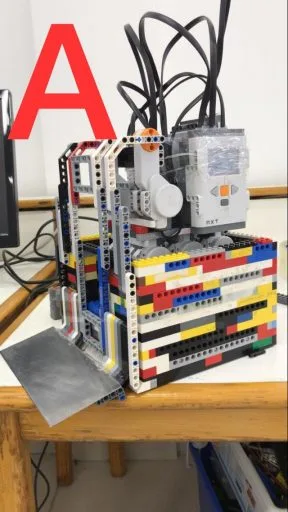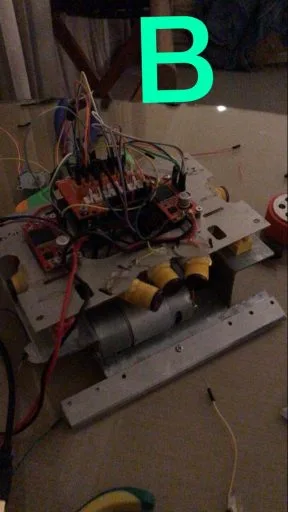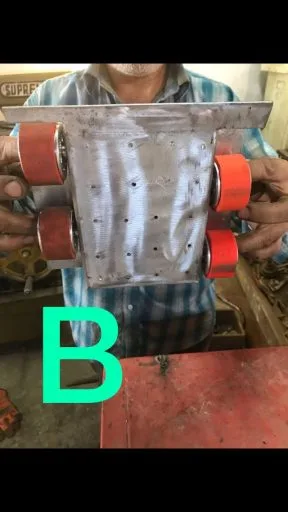Abstract
The paper introduces Robot Sumo, which has taken the world stage by surprise as a friendly type of fight similar to the famous sport of sumo. The article then explains the nature and kind of rules that exist and are recognizable during a robot sumo fight. Also, the competitive advantages that give a competitive edge to any two robots are discussed intensely in the paper. The methodology applied, and the participants who helped create robot A and robot B for this fight are credited and acknowledged for their contribution. The article then further states the procedure for the construction of both the robots in length as well as the statement of the material used for their development, respectively. In the fight, robot B emerged victorious due to the advantages it had over the robot in terms of torque, speed, design, and programming, greatly increasing its strength and agility in the battle ring.
Introduction
There have been people who have been using robots in spectator sports such as in the Battlebots. However, there has been the rise of Robot Sumo, which is different from the original fighting bots. Robot sumo has the same objective as the parent game sumo, where the opponent robot isn’t allowed to destroy the opponents or to turn them into a heap of pile junk, but they push the robot out of the ring. It is this execution of this process by the robots that makes the sports fun and entertaining to watch.
According to Wyffels et al. (2011), another exciting thing about the robot’s fight in the Robot sumo is that the robots are completely autonomous and not controlled by humans. The robots duke it out because they want and not because they are told to duke it out. The robots are fitted with many sensors, whose objective is to detect the opponent as well as creatively create mechanical arms, lifts, and sheer brute force to accomplish their goals. The robots are, however, built differently to withstand different pressures; some are created fast to zip around, aiming for the killing blow, while some are slow and able to resist continually being pushed by the faster robots. Although robot sumo seems like an informal sport, there have been extensive rules that have been set up objectively to govern the fight, ranging from the ring size and the type of jamming to flammable materials.
The rule of this game is quite that the winner is determined when the first robot flips the second robot out of the rig, and the remaining robot wins. The sumo ring is typically four feet across the distance, including a two-inch outskirt situated on the ring’s fringe. The surface of the ring, nonetheless, is smooth plywood that is painted level dark and sits about one and a half inches off the ground level. The two robots fighting are usually set around ten Lego studs separated, which is an equivalent separation from the rings inside. A robot is thought to be vanquished when both of its units are handicapped or expelled from the ring or part of the robot tumbles off the edge and thus touches the floor. In a competition, there are two points given for a win, one for a draw and zero for a loss. There are no changes in programming that should be conducted during the match, and the use of flying competes in the fights.
According to Do et al. (2016), one of the significant factors that determine the winning of the robot is the tyres if the two robots are entirely matched. Whereas better tyres have a better grip on the surface of the ring and shove better unless they are severely underpowered, narrow, worn tyres spell disaster since they can push around easily (Benavidez et al., 2012). Another significant element is the scoop or arm, which is usually designed to shift the opponent off their weight, reducing the grip of the opponent’s robot and increasing the scooper’s grip. Choosing the color of the robots is a crucial factor because, for example, dark robots cannot be easily seen by infrared, however, these sensors increases the chance to efficiently fight in contacting the mobile robots and hence attack effectively. Finally, the slick encased robes are usually slippery, which provides a difficult time for the opponent to have a grip.
Method
Participants
- Dr. Max (team coach) (his mission was to supervise us, encourage us, and solve any technical issues)
- Mr. Adel (art and design teacher) (solved some design issues of the robot regarding the stabilization of the body and the wheels)
- Mr. Ansar (workshop owner) (I gave a 3d design of the robot to him, and Ansar made the metallic model)
Materials
We made two robots, A&B
Robot A
- 2 LEGO EV3 brains
- 8 LEGO NXT motors
- 12 LEGO Gear with 40 teeth
- 12 LEGO Gear with 24 Teeth
- 2 LEGO EV3 ultrasonic sensors
- 2 LEGO EV3 color sensors
- One metallic blade
- 12 cables
- Two Lego EV3 batteries
Robot B :
- ArduPRO Robot Controller (With Arduino Nano)
- 2 QTR1A Contrast (Edge) Sensor
- 5 Mz80 Infrared Sensor
- Cytron SmartDriveDuo Smart Dual Channel 10A Motor Driver
- 4 DC 12V 300RPM Geared Motor High Torque 37GB-550 Gear Reducer Motor
- PROFuse 3S 11.11V high-quality Li-PO battery 1750mAh 25C
- Four silicon wheels
- Wires
- Blade
- The metallic body
- 9V battery ENERGIZER
- Screws
Procedures
According to the competition, the construction of a robot needs to have specified dimensions, a minimum width of 20 cm and a maximum length of 20 cm, but the height isn’t defined. Also, it is vital to consider the shape of the robot as well as the weight, which should not exceed their kilograms. For the construction of robot A, the first step is the construction of was to draw a 3-D image of the design. Then, the attachment of both the sides, bottoms, and servos, as well as the battery and lower ramp, is done using Velcro. Then the wheels are screwed in place, and spacers are added to electronic mounts. The next step is to assemble the ultrasonic and colour sensors, then add the upper ramp before attaching electronics and attaching Velcro for scanners. Finally, the top components are put in place.
For the second robot, B, one of its main components is the ArduPRO Robot Controller, which acts as the motherboard, linking and controlling all the parts of the robot. According to Bagnall (2014), the first step in making this robot is to solder all the electronic systems that are used to control the motors together so that they will communicate with each other effectively. The next process is attaching the wheels to the shaft towards the motors and ensuring that they are tightly fixed. Then, the base of the robot is attached, ensuring that everything fits together wholly and cleanly. The following step is to attach the back and battery support as well as the front ramp support, taking into consideration that they are secured. The next step is to connect the electronics, such as the batteries and the wires, before making the robot wedge. Finally, the battery and the top of the ramp are fixed, and the controller fixes are conducted to ensure that the robot moves around quickly.
The two robots are then programmed as below:
When the program begins, the robot will wait 5 seconds. Later, the two arms will drop with the blade; after that, it will move straight 20cm, and then the robot will start rotating until the Ultrasonic sensors detect the opponent; after that, the robot will attack the opponent and strike it with the blade from dawn. If the robot reaches the white line, the light sensors will command the robot to turn back to avoid the corner.
The structures of the robots regarding its components and body shape greatly determine how well a robot performs in a fight. When installed with motors of different types, two different robots will have different revolutions per minute, influencing their speed and increasing their prey instincts. Also, these motors have different torque that give different strengths to any two robots possessing two different motors. Torque determines the strength of the robot and how effectively a robot will attack another robot in the first instance by overcoming friction (Liu and Zhang, 2004). Also, the type of intelligence system will determine the number of strategies that robots will be able to be programmed in, during a fight. For example, Arduino used in robot B can be programmed to run three different strategies at a go, unlike robot A which can only a single programmed at a go, giving a competitive advantage to the robot B.
Robot (B) has three different strategies that must be chosen before the match. The first strategy goes straight to the opponent; the second goes right. To attack the opponent, the third goes to attack the opponent. Due to the five IR sensors, there is no need to rotate to find the opponent. The robot will find it and attack it directly. In all strategies, the robot moves back when it sees the white ring of the match table.
Results
The results of a sumo fight between the two robots, A and B, produced the expected win for robot B. The success is a contribution of various factors such as the strengths, speed, and torque of robot B with regards to robot A. Robot B is fitted with the Cytron SmartDriveDuo Smart Dual Channel 10A motor driver and 4 DC 12V 300RPM geared motor high torque 37GB-550 gear reducer motor, while robot A is equipped with 8 LEGO NXT motors. The motors in robot B are much stronger regarding torque and revolutions per minute, making robot B stronger and faster than robot A.
For robot A, the measured torque is 220.4 N/cm with an 88.5 rpm, hence determining its speed. Also, the programming strategy of this robot allows only one approach at a time. The advantage robot B has over robot A is indicated in the number of rpm and torque that is 300 and 220 N/m, making robot b faster, stronger and agiler than robot A in the sumo robotics. Also, another advantage is that, unlike robot A, robot B can be programmed with three different strategies of fighting, giving it a competitive edge in the fight.
It is the advantage that robot B possesses over robot A regarding torque, rpm, and agility that gave robot B a win over robot A. Robot B is much stronger as a result of the direct impacts of these advantages, which gives it a competitive edge on the battle ring.
Discussion
Robot B emerged victorious because of the three different strategies, along with the speed and high torque. Also, robot (B) won because of the top features of the body and the policies that were used in programming. The robot won all competitions quickly and without spending any effort.
However, Robot A similarly had great features and successful programming, but the robot couldn’t win the match with Robot (b) because Robot B was much stronger than Robot (A). But in the end, robot (A) won the national competition with 3rd place.
References
Bagnall, B. (2014). Maximum LEGO EV3: Building Robots with Java Brains. Variant Press.
Benavidez, P., Gleinser, C., Jaimes, A., Labrado, J., Riojas, C., Jamshidi, M., & Endowed, L. B. (2012, June). Design of semi-autonomous robots for competitive robotics. In World Automation Congress (WAC), 2012 (pp. 1-6). IEEE.
Do, H. M., Kim, G. H., Choi, T. Y., Kim, D. H., & Son, Y. (2016, August). Development of simulation model for modular and reconfigurable robots. In Ubiquitous Robots and Ambient Intelligence (URAI), 2016 13th International Conference on(pp. 138-139). IEEE.
Liu, J., & Zhang, S. (2004). Multi-phase sumo maneuver learning. Robotica, 22(1), 61-75.
Miles, P. (2002). Robot Sumo: The Official Guide. McGraw-Hill, Inc.
Wyffels, F., Bruneel, K., Kindermans, P. J., D’Haene, M., Woestyn, P., Bertels, P., & Schrauwen, B. (2011). Robot competitions trick students into learning. In Proceedings of the 2nd International Conference on Robotics in Education, Rio(pp. 47-52).
Cite This Work
To export a reference to this article please select a referencing stye below:












